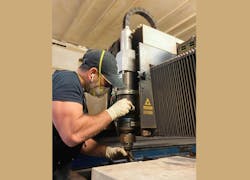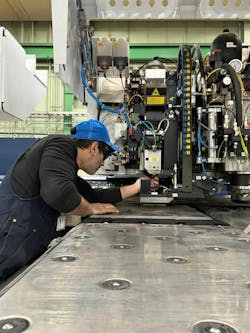Zero downtime goal: A preventative maintenance guide for CNC lasers
Understanding your laser is the key to ensuring it continues to perform as expected. Regular maintenance helps maintain the precision and accuracy of your cuts, which is crucial to meet tight tolerance and consistent quality requirements. Well-maintained equipment also operates more efficiently, which leads to energy savings and reduced operating costs.
Ultimately, preventive maintenance also ensures that a shop maintains production schedules and resource allocation.
Key machine components of a laser cutting machine require particular attention. Skilled laser technicians will specify when certain maintenance processes should be performed.
The basic components of a laser include the cutting table, laser source, chiller, pallet changer, and dust collector. Each component requires careful scrutiny when it comes to maintenance.
Machine tool
The “machine tool” encompasses the various mechanical parts required to run the machine, not including the laser source itself. This includes the need to lubricate the rack and pinion X, Y, and Z axes, and the guide rails. Your machine tool supplier likely suggests a lubrication maintenance schedule based on the amount it is used. Be sure to check it carefully.
The axis limits of a machine will change with wear and tear, and can cause program functionality problems. Review these axis limits regularly to ensure you are still adhering to specifications.
Make regular visual checks on the bellows for your rack and pinion system to ensure no dirt is penetrating it. Similar checks of water connections should be done to look for cracks and kinks. Change cooling water filters per the manufacturer’s instruction (usually annually), as well as gas filters for the laser.
Be sure to install a 0.01-µm filter in the nitrogen supply line to safeguard the laser system from potential contaminants. Lasers have a compressed air intake that can carry dust, dirt, oil, and moisture. Without minimum yearly machine filter changes, these contaminants can enter the machine’s internal components and cause wear, corrosion, and reduced efficiency.
Other key safety points to tackle include checking emergency stops, reset, and pause buttons to ensure they work properly. Perform a visual inspection of warning lamps as well.
For eye safety, check the protective windows on a fiber laser and all possible points of egress for light from the cutting area. To do this, use a flashlight in a dark room and run it around all possible egress points.
Laser
The laser itself is probably the least likely part to be overlooked for inspection, but it’s worth reviewing essential points that need to be checked.
Nitrogen input to a fiber laser is key. If it is compromised, it will affect the kerf and cleanliness of your cut. New or maintained gas regulators will ensure the correct pressure is delivered. Gas leaks often occur with worn regulators, which can be costly. Check the lateral air blast nozzle for cleanliness to ensure it’s not plugged with spatter. Cutting issues can result if the nozzle isn’t checked.
Clean the nozzle changer regularly, and check the alignment of the head to the nozzles when changing. Be sure to clean the calibration plate as well.
Performing a visual inspection of the laser while it is running can also be helpful to capture any issues.
Lastly, remember to have your service engineer check internal fans for cleanliness. Improper airflow can hamper all other components.
Pallet changer
The pallet changer is just as important as any other part of the machine in keeping it running smoothly. There are several items that need to be reviewed regularly.
First, check the lateral guideways and readjust them if necessary. Guideways are where the pallet wheels are guided into the pallet changer, so it’s important to ensure no scrap is in there. Any hindrance can cause the wheels to jump the track and cause all kinds of problems.
Check the oil level and the rest of the hydraulic system to ensure there are no leaks. Be sure to also check how often the hydraulic oil requires changing. Depending on the manufacturer, it can be required every three to five years. Don’t forget to bring the table down first before changing the oil.
Check the motor chains to ensure they are securely attached, and lubricate as necessary. The chain deflection will be specified in your machine’s maintenance manual.
Check the wheels on the pallet changer for chips. After installations, settling of the machine can cause misalignment of the pallet with the machine tool. This can cause the wheels to wear prematurely. A good preventive maintenance practice is to check and realign or level beds to ensure smooth operations.
Measure the step between A/B pallet rails and the processing machine to check that they are within tolerance value. If there is no step but you hear an abnormal sound, look under the table to see if there is an obstacle or damaged section on the wheel.
Chiller
The chiller is the cornerstone of effective temperature management in CNC laser systems. It circulates a coolant to extract heat from the laser and dissipate it through a heat exchanger system. Before summer heat sets in, it is crucial to conduct a comprehensive checkup of the chiller system.
Be sure to measure factory water conductivity to reduce the corrosion of metal parts, which can degrade the laser system’s performance.
Also replace water at factory recommended intervals (typically every 12 months). This is critical with deionized water, which will become acidic due to its high affinity to absorb carbon dioxide from the air. Manufacturers often add anticorrosion inhibitors during water changes to combat it.
Change filters at the same time you replace water. Dirty or clogged filters restrict flow and reduce the chiller’s ability to cool effectively. Condenser fins cleaning also is important. Always start this process with the power switched off. Condenser fins should be vacuumed with a brush attachment. Blowing condenser fins tends to send dust into the atmosphere, which is not recommended around fiber laser sources. Filter mats should also be replaced, and steel filter mats blown outside. Always wear an appropriate dust mask when performing this job.
Pro tip: Use a condenser comb to straighten bent fins during maintenance. This is a key step to improve efficiency and longevity of your chiller.
Strainers and leaks
Y strainers mechanically remove solids and other particles when fluid flows through it. We often receive calls for chiller system blockages and find that the Y strainer is blocked. You can blow them out to achieve a temporary fix, but it is recommended to replace the strainer yearly with water changes.
Inspect the chiller system for leaks. Even small leaks can lead to significant loss of coolant over time, which can drastically impact the cooling efficiency.
Dust collectors/filter changes
Dust collectors are a key component in laser cutting systems because they help maintain a clean working environment, improve the quality of laser operations, and protect both equipment and personnel from harmful particulates.
The dust collector is the most important piece of equipment on your laser system. Proper dust collector maintenance helps ensure safety and proper function.
Pressure drop is a crucial performance indicator for dust collectors as dirty air passes through filters. It measures the difference in pressure between the air entering and exiting the filter. When filters clog, resistance increases, which leads to a decrease in pressure, because it requires more energy to maintain airflow and makes the fan motor work harder.
Monitoring the pressure drop indicator gauge helps determine when filters need cleaning or replacement.
Inspect purging valves
Solenoid valves are triggered in sequence in dust collectors by controlling the powerful bursts of compressed air for cleaning the filter. A pulse pipe is a manifold that delivers the compressed air through orifices to the filter media. Alignment checks ensure solenoids are delivering air effectively to dislodge dust from the filter’s surface.
Fan motors
Conduct weekly inspection of the blower to check for excessive vibration, amp draw, and the condition of the drive belt.
It’s easy to believe that as long as your laser is cutting cleanly, there is no way a critical failure is imminent. But without properly maintaining the laser head, the machine tool’s mechanical components, the pallet changer, and the dust collector, a failure may be closer than you think.
No one can afford downtime in this environment of just-in-time delivery of components. Make sure your laser keeps you as productive as possible by giving it the attention it requires.

